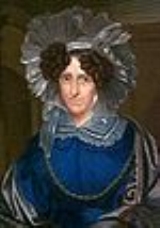
Luise Eleonore of Hohenlohe-Langenburg
Encyclopedia
Princess Luise Eleonore of Hohenlohe-Langenburg (11 August 1763, Langenburg
– 30 April 1837, Meiningen
) was a German noblewoman. She was duchess and (from 1803 to 1821) Regent of Saxe-Meiningen
.
and his wife Princess Karoline of Stolberg-Gedern (1732–1796).
, she married George I, Duke of Saxe-Meiningen. They had three children:
, which for the next decade ravaged the Saxon states. The duchy was forced to join the Confederation of the Rhine
during these Wars and provide it with troops; afterwards the duchy was struck with famine, which Luise sought to prevent by importing wheat. Despite the fact that French and later Russian armies marched back and forth across the country, Luise refused to flee; she stayed with her infant son and two daughters inside their castle. She used every strategy to preserve the autonomy of her regency, so that when she joined the Allies in 1813, she had saved the duchy for her son. He became the ruling Duke of Meiningen eight years later. By adjustments in the duchy's administration she ensured the duchy was better managed and in 1821 opened the Gymnasium Bernhardinum in Meiningen (already begun by her husband).
Her children were carefully educated, with a grand tour
to Italy under their tutor Johann Heinrich Pestalozzi
. After her son came of age, Luise went on several foreign trips, including one to England to visit her daughter Adelaide.
Langenburg
Langenburg is a town in the district of Schwäbisch Hall, in Baden-Württemberg, Germany. It is located on a hill above the river Jagst, 18 km northeast of Schwäbisch Hall...
– 30 April 1837, Meiningen
Meiningen
Meiningen is a town in Germany - located in the southern part of the state of Thuringia and is the district seat of Schmalkalden-Meiningen. It is situated on the river Werra....
) was a German noblewoman. She was duchess and (from 1803 to 1821) Regent of Saxe-Meiningen
Saxe-Meiningen
The Duchy of Saxe-Meiningen was one of the Saxon duchies held by the Ernestine line of the Wettin dynasty, located in the southwest of the present-day German state of Thuringia....
.
Family
Louise Eleonore was a daughter of Prince Christian Albert Louis of Hohenlohe-LangenburgChristian Albert, Prince of Hohenlohe-Langenburg
Christian Albert, Prince zu Hohenlohe-Langenburg was the second ruling Prince of the House of Hohenlohe-Langenburg and a Dutch lieutenant-general....
and his wife Princess Karoline of Stolberg-Gedern (1732–1796).
Marriage
On 27 November 1782, in LangenburgLangenburg
Langenburg is a town in the district of Schwäbisch Hall, in Baden-Württemberg, Germany. It is located on a hill above the river Jagst, 18 km northeast of Schwäbisch Hall...
, she married George I, Duke of Saxe-Meiningen. They had three children:
- AdelheidAdelaide of Saxe-MeiningenPrincess Adelaide of Saxe-Meiningen was the queen consort of the United Kingdom and of Hanover as spouse of William IV of the United Kingdom. Adelaide, the capital city of South Australia, is named after her.-Early life:Adelaide was born on 13 August 1792 at Meiningen, Thuringia, Germany...
(later Adelaide, 1792–1849), with whom Luise had a very close relationship - in 1818 she married king William IV of the United KingdomWilliam IV of the United KingdomWilliam IV was King of the United Kingdom of Great Britain and Ireland and of Hanover from 26 June 1830 until his death...
and special taxes needed to be instituted in the duchy to raise funds for her enormous dowry. - Ida (1794–1852), married Prince Bernhard of Saxe-Weimar-Eisenach.
- Bernhard II, Duke of Saxe-Meiningen, (1800–1882), married Princess Marie Fredericka of Hesse-Kassel (1804–1888).
Regency
When her husband died on 24 December 1803, she took over as regent of the duchy for their son Bernhard II, Duke of Saxe-Meiningen. She ruled with energy, courage, and good sense during the Napoleonic WarsNapoleonic Wars
The Napoleonic Wars were a series of wars declared against Napoleon's French Empire by opposing coalitions that ran from 1803 to 1815. As a continuation of the wars sparked by the French Revolution of 1789, they revolutionised European armies and played out on an unprecedented scale, mainly due to...
, which for the next decade ravaged the Saxon states. The duchy was forced to join the Confederation of the Rhine
Confederation of the Rhine
The Confederation of the Rhine was a confederation of client states of the First French Empire. It was formed initially from 16 German states by Napoleon after he defeated Austria's Francis II and Russia's Alexander I in the Battle of Austerlitz. The Treaty of Pressburg, in effect, led to the...
during these Wars and provide it with troops; afterwards the duchy was struck with famine, which Luise sought to prevent by importing wheat. Despite the fact that French and later Russian armies marched back and forth across the country, Luise refused to flee; she stayed with her infant son and two daughters inside their castle. She used every strategy to preserve the autonomy of her regency, so that when she joined the Allies in 1813, she had saved the duchy for her son. He became the ruling Duke of Meiningen eight years later. By adjustments in the duchy's administration she ensured the duchy was better managed and in 1821 opened the Gymnasium Bernhardinum in Meiningen (already begun by her husband).
Her children were carefully educated, with a grand tour
Grand Tour
The Grand Tour was the traditional trip of Europe undertaken by mainly upper-class European young men of means. The custom flourished from about 1660 until the advent of large-scale rail transit in the 1840s, and was associated with a standard itinerary. It served as an educational rite of passage...
to Italy under their tutor Johann Heinrich Pestalozzi
Johann Heinrich Pestalozzi
Johann Heinrich Pestalozzi was a Swiss pedagogue and educational reformer who exemplified Romanticism in his approach....
. After her son came of age, Luise went on several foreign trips, including one to England to visit her daughter Adelaide.

